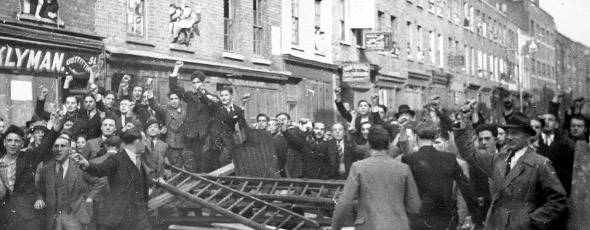Cable Street remembered

By Sam Gordon
November 2, 2019 — Links International Journal of Socialist Renewal — In October 1936, events occurred in the East End of London that captured the attention of Left political activists for a generation.
World War I had laid waste to much of the industrial world and rejigged the colonial boundaries of Africa and the Middle East. The cold fog of the 1930s Great Depression had reinforced the Dickensian perception to east London. It was a place full of foreigners and poverty. It was seen by many as a place to be avoided.
Many were Jewish of east European origin. They worked in sweatshops in the garment industry and cabinet making. There were also Irish Catholics who toiled in the nearby London docks.
Rented accommodation, often barely affordable, provided sometimes uneasy living space for the two communities.
In 1912, strikes by Jewish garment workers and Irish dockers swept east London. Both communities saw evictions due to an inability to pay rent.
Sir Oswald Mosley, the leader of the British Union of Fascists (BUF), had the poor Jewish population of London’s East End boroughs of Whitechapel and Stepney firmly in his sights. His objective was clear: Spread the word that these immigrant Jews were the cause of high unemployment, despite the fact that many of them were themselves unemployed.
Leading from his Rolls Royce, he planned to march thousands of uniformed BUF thugs through the streets. In this he was in line with his contemporaries: Adolf Hitler in Germany, Benito Mussolini in Italy, Francisco Franco in Spain and António de Oliveira Salazar in Portugal.
On October 4, 1936, an estimated 2-3000 fascists turned up, fewer than had been predicated. Yet trouble was expected. Estimates of the number of police protecting them vary between 7-10,000.
The government of Conservative Prime Minister Stanley Baldwin had no problem with the march and refused to ban it. Baldwin has an impressive track record of avoiding any form of confrontation with fascism during the 1930s.
The Board of Deputies of British Jews, then as now, sought respectability with the British establishment. For this it was and is rewarded with respectability, which it reciprocated. Its recommendation to the East Enders that October was: Don’t get involved.
The official Labour Party position was the same. As was that of the trade unions in the form of the London Trades Council.
The Communist Party had already organized an anti-fascist meeting in central London’s Trafalgar Square, supporting Republican Spain fighting General Franco.
The Jewish community of East London, alongside their Irish Catholic neighbours and local English people claiming no particular minority identity, had other ideas.
The stage was set and all the props were assembled for whatever was to happen in the East End to be a side show at best. Well, it didn’t work out that way. The dingy streets of east London’s Whitechapel and Stepney were where the action was at.
More than 80 years on, new perspectives have come into focus which were blurred for decades. Puff pieces have been written about the sterling roles played by Irish labourers, the Communist and Labour parties, assorted Lefties, working class solidarity and Jewish identity. All undeniably true.
But in recent years other truths have emerged from which to enrich our practice of struggle.
That Sunday was a day of no pasarán (They will not pass).British fascism did not receive a death blow, but in open confrontation, with all the police the state could muster, fascism received a knockback.
World War II followed and the East End of London was bombed to pieces. But a tradition with myths, nuances and gems was born.
The goings on at Cable Street has been well documented and argued over. The people versus the BUF; the people versus the police, baton charging and mounted police. Paving stones, commandeered vehicles, anything that came to hand including the contents of chamber pots hurled from upstairs windows were the weapons of choice.
The biggest stake holder in what has passed into history as the Battle of Cable Street – the main locale of confrontation - is a variety of shades of socialist opinion and practice. An alliance of Jewish, Irish and wider working class understanding has provided hope and inspiration for succeeding generations.
The main organiser, motivating and mobilising the diverse population of East London, was communist Joe Jacobs. He also defied the leadership – remember the initial call was to assemble at Trafalgar Square - of his own party which he had helped elect. For this indiscipline he was booted out of the party.
Nevertheless, over the years, the party and the Left in general have lauded its role in putting the blocks on the free passage of fascism.
Cable Street has earned a place in the hedonism of the Left. That’s what gives us our strength, our identity, our raison d'être. But other stories have emerged from that place, time and community.
A known fascist sympathizer and his family were to be evicted because he could not afford to pay the rent on the place where he lived. The landlord sent the bailiffs to evict him. But, on a smaller scale, the bailiffs met the same threatening opposition as had Mosley and his Blackshirts. The bailiffs retreated.
“How can you protect that fascist,” some understandably asked? The explanation was as simple as it was strong and determined. “He lives here, he’s one of us, and we’ll sort it out ourselves.”
Many on the Left look favorably to institutions with which they have shared values, traditions and membership. For instance, trade unions, identity groups and political parties. But there is another presence which ebbs and flows with varying levels of energy. Community.
As the Battle of Cable Street shows, a variously dormant, uneasy, vibrant community and the well-established interest groups do not always make that much needed connection.
But sometimes they do.